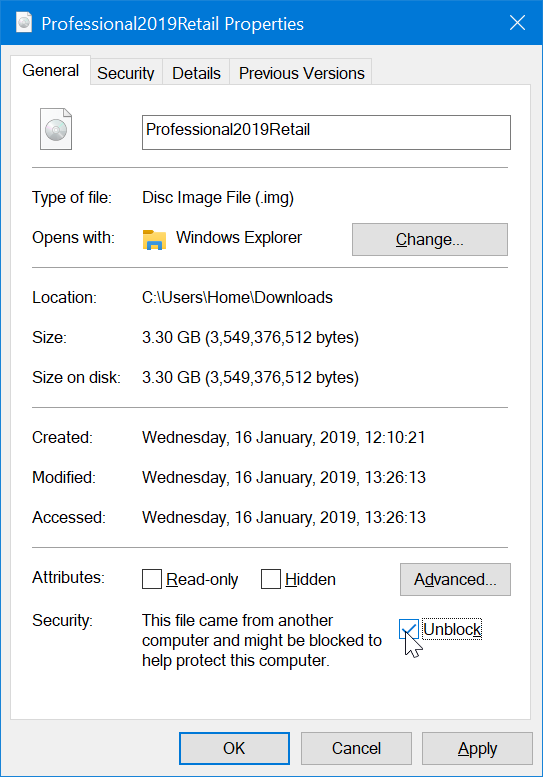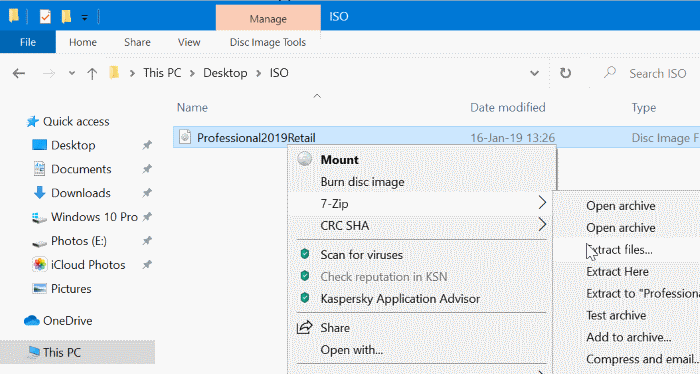Windows 10 supports mounting ISO and IMG files. With this functionality, one can mount ISO and IMG files without using any third-party software.
However, at times, when mounting an ISO or IMG image file, you might get “Sorry, there was a problem mounting the file” error.
If you are also getting the same error while attempting to mount an ISO or IMG file, you can try out the given below solutions, in that order.
Solution 1 of 9
Copy and paste the ISO/IMG to a different location
When you get the error, copy and paste (do not use the move functionality) the ISO/IMG image file in question to another location (preferably a different drive) on your computer and then try to mount the same. But why so? Some download managers add “P” (sparse file) attribute to large files. This sparse file attribute is not supported by the disc mounting utility.
Solution 2 of 9
Check if the ISO/IMG file is blocked
Files downloaded from the internet might have been blocked by Windows 10. This often happens for all file types. The Attachment Manager in Windows blocks some files downloaded from the internet or sent via emails. To check if the file is blocked and unblock the file:
Step 1: Browse the folder containing the ISO/IMG file. Right-click on the ISO/IMG file and click Properties.
Step 2: In the General tab, select the Unblock checkbox and then click the Apply button.
Solution 3 of 9
Restart the File Explorer
Many times, restarting the File Explorer fixes the error. To restart the File Explorer or Windows Explorer, do this:
Step 1: Open the Task Manager. Click on More details.
Step 2: Under the Processes tab, look for Windows Explorer entry, right-click on it and then click the Restart option.
Solution 4 of 9
Check if the ISO/IMG file is corrupted
Although the disc mounting utility displays “The disc image file is corrupted” error message when the ISO/IMG file is corrupted, it might show “Sorry, there was a problem mounting the file” error even when the file is corrupted.
If you are trying to mount a Windows/Linux operating system ISO/IMG file, refer to our how to check if an ISO/IMG is a bootable guide to check the working status of the file.
Solution 5 of 9
Extract ISO/IMG file content using a file archiving tool
If the ISO/IMG file contains a non-bootable Windows or Linux operating system, you can use file archiving utilities such as the 7-ZIP (free) to extract the ISO/IMG file contents. To extract the ISO/IMG file content:
Step 1: Install 7-Zip if not already installed on your computer.
Step 2: Right-click on the ISO/IMG file, select 7-ZIP, and then select Extract files or Extract here.
Solution 6 of 9
Check if the ISO/IMG is already mounted
With default settings, when you try to mount an ISO/IMG file that is already mounted, Windows 10 open the mounted ISO/IMG folder. That said, it might throw the error mentioned above in some cases.
So, please check if the ISO or IMG file is already mounted. Mounted ISO/IMG files show up in This PC. To unmount, right-click on the mounted drive and then click the Eject option.
Solution 7 of 9
Uninstall third-party ISO manager
A third-party ISO mounting program or ISO manager might be conflicting with the built-in disc mounting utility. If you have installed any, uninstall it and then try mounting the ISO/IMG file using the built-in tool.
Solution 8 of 9
Download the ISO/IMG file again
If you are suspicious that the ISO/IMG file might have been corrupted, you can try downloading it again. You should not get “Sorry, there was a problem mounting the file” error.
Solution 9 of 9
Use a third-party file mounting software
As a last resort, you can try using third-party mounting software. There are many free ISO mounting solutions around for Windows 10. We recommend Virtual CloneDrive, which has been around for more than a decade now.



